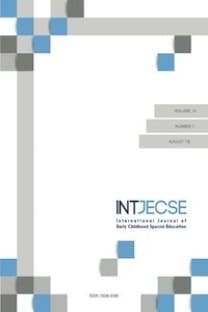Gana'da Erken Bakım Hizmeti Alan Yetersizliği Olan Çocuklar
Bu araştırma Gana'nın devlet okulu sınıflarında 4-8 yaş aralığındaki yetersizliği olan çocuklarla çalışan öğretmenlerin tecrübelerini incelemektedir. Ayrıca öğrencilerin özel durumlarıyla başa çıkmada yardımcı olmak için kullanılan yönetim stratejileri incelenmiştir. Beş araştırmacıdan oluşan bir ekip özel gereksinimli çocukları eğitmekte olan 68 öğretmen ile görüşmeler gerçekleştirmiştir. Sonuçlar, öğretmenlerin çoğunluğunun özel gereksinimli çocukların sınıflarında kaynaştırma eğitimine katılmasını desteklediğini fakat gerektiği gibi bir eğitim için uygun kaynakların yetersizliği konusunda endişeli olduklarını ortaya koymaktadır. Ayrıca katılımcılar özel gereksinimli çocukların yaklaşık %60'ının grup çalışmalarına katılmak istemediklerini belirtmişlerdir. Öğretmenler için en çok zorlanılan konular bazı öğrencilerin basit yönergeleri takip etmelerini sağlamakta ve ebeveynleri özel gereksinimli çocuklarının eğitimlerine katmakta yaşadıkları zorluklar olarak ortaya çıkmıştır. Bu çalışma Gana'daki okullarda ebeveynlerin katılımını destekleyecek ebeveyn-öğretmen işbirliklerinin oluşturulmasını tavsiye etmektedir. Ayrıca bu araştırma Gana'daki sınıflarda çalışmakta olan öğretmenlere yardımcı olacak özel eğitim öğretmenlerinin, hemşirelerin ve sosyal çalışmacıların görevlendirilmesini önermektedir.
Children with Disabilities in Early Care in Ghana
This study examined the experiences of teachers who teach 4- to 8-year-old children with special needs in Ghanaian public school classrooms. Also examined were the management strategies put in place to assist the children in dealing with their unique situations. A team of five researchers interviewed 68 teachers who teach children with special needs. Results indicate that a majority of the teachers support inclusion of children with special needs in their classrooms but were concerned about the lack of appropriate resources for proper instruction. In addition, participants indicated that about 60% of children with special needs did not want to participate in group work. The most challenging issues for the teachers involve difficulty getting some of the children to follow basic instructions and also getting parents to participate in the education of their children with special needs. This study recommends parent-teacher associations advocating for the participation of parents in schools in Ghana. The study additionally recommends employing special education teachers, nurses, and social workers to assist teachers in Ghanaian classrooms.
Keywords:
Early care, inclusion, Ghana, special needs narrative analysis.,
___
Baker, E., Wang, M., and Walberg, H. (1994). The effects of inclusion on learning. Educational Leadership 52, 33-35.Banerji, M. & Dailey, R. A. (1995). A study of the effects of an inclusion model on students with specific learning disabilities. Journal of Learning Disabilities 28(8), 511-522.
Connelly, F.M. & Clandinin, D.J. (1990). Stories of experience and narrative inquiry. Educational Researcher 19(5), 2-14.
Council for Exceptional Children, Gale Group, Farmington Hills, Michigan.
D’Alonzo, B.J., Giordano, G. & Vanleeuwen, D.M. (1997). Perceptions by teachers about the benefits and liabilities of inclusion. Preventing School Failure 42(1), 4-10.
Fuchs, D. and Fuchs, L. (1995). What’s special about special education? Phi Delta Kappan 76, 522-530.
Gargiulo, R.M.; Sluder, L.C.; and Streitenberger, D. (1997). Preparing Early Childhood Educators for Inclusive Programs: A Call for Professional Unification. Early Childhood Education Journal 25(2), 137-139.
Giangreco, M. F. and Putnam, J.W. (1991). Supporting the education of students with severe disabilities in regular education environments. In Critical issues in the lives of people with severe disabilities, ed. M.H. Meyer, C.A. Peck, and L. Brown, 245-270. Baltimore: Paul H. Brookes.
Harry, B., Allen, N. & McLaughlin, M. (1995). Communication versus Compliance: African-American Parents' Involvement in Special Education. Exceptional Children 61(4), 17-21.
King, I. (2003). Examining middle school inclusion classrooms through the lens of learner-centered principles. Theory into Practice 42(2), 151-157.
Lee, J. (1997). Women re-authoring their lives through feminist narrative therapy. Women and Therapy 20(3), 1-22.
McLeskey, J. & Waldron, N. (1995). Inclusive elementary programs: Must they cure students with learning disabilities to be effective? Phi Delta Kappan 77, 300- 303.
Morrison-Beedy, D., Cote-Arsenault, D, & Feinstein, N.F. (2001). Maximizing results with focus groups: Moderator and analysis issues. Applied Nursing Research 14(1), 48-53.
Patton, M.Q. (1990). Qualitative evaluation and research methods. 2nd ed. Newbury Park, CA: Sage.
Pugach, M. C. & C. L. Warger. (1993). Curriculum considerations. In Integrating general and special education, ed. J. I. Goodlad and T. C. Lovitt, 135-148. New York: Merrill.
Rieser, R. (2008). Implementing inclusive education: A Commonwealth guide to implementing Article 24 of the UN convention on the rights of people with disabilities. London: Commonwealth Secretariat.
Rogers, J. (1993). The inclusion revolution. Phi Delta Kappan 11, 1-6.
Roncker V. Walter, 700F.2d 1058-1063 (6th Cir. 1983).
Sailor, W. (1991). Special education in the restructured school. Remedial and Special Education 12(6), 8-22.
Sailor, W., Gee, K., & Karasoff, P. (1983). Full inclusion and school restructuring. In Instruction of students with severe disabilities, ed. Snall, M.E., 1-30. New York: Merrill.
Salisbury, C.L. (1991). Mainstreaming during the early childhood years. Exceptional Children 58(2), 146-155.
Shanker, A. (1995). Full Inclusion is neither free nor appropriate. Educational Leadership 52(4),18-21.
Sharpe, M. & Hawes, M. (2003). Collaboration between general and special education: Making it work. Minneapolis, MN: National Center on Secondary Education and Transition.
Siperstein, Gary N., Parker, Robin C., Bardon, Jennifer Norins, & Widaman, Keith F. (2007). A national study of youth attitudes toward the inclusion of students with intellectual disabilities. Exceptional Children 74(4), 435-455.
Smith, P.K. & Pepler, D.J. (2004). Bullying in schools: How successful can interventions be? Cambridge: Cambridge University Press.
Snell, M.E. & Janney, R. (1993). Including and supporting students with disabilities within general education. In Program leadership for students with disabilities, ed. Billingsley, B. S., 219-262. Richmond, VA: Virginia Department of Education.
Staub, D. & Peck, C. (1995). What are the outcomes for non-disabled students? Educational Leadership 52(4), 36-41.
Tichenor, M.S., Heims, B., & Piechura-Couture, K. (1998). Putting principles into practice: Parent perceptions of a co-taught inclusive classroom. Education 118(3) 71-78.
United Nations Educational Scientific and Cultural Organisation. (2009). Policy brief on early childhood. http://unesdoc.unesco.org/images/0018/001831/183156e.pdf. (Accessed October 29, 2010).
- ISSN: 1308-5581
- Başlangıç: 2009
- Yayıncı: İbrahim H. DİKEN
